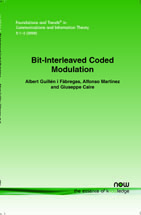Bit-Interleaved Coded Modulation
By Albert Guillén i Fàbregas, Department of Engineering, University of Cambridge, UK, guillen@ieee.org | Alfonso Martinez, Centrum Wiskunde & Informatica (CWI), The Netherlands, alfonso.martinez@ieee.org | Giuseppe Caire, Electrical Engineering Department, University of Southern California, USA, caire@usc.edu
Abstract
The principle of coding in the signal space follows directly from Shannon's analysis of waveform Gaussian channels subject to an input constraint. The early design of communication systems focused separately on modulation, namely signal design and detection, and error correcting codes, which deal with errors introduced at the demodulator of the underlying waveform channel. The correct perspective of signal-space coding, although never out of sight of information theorists, was brought back into the focus of coding theorists and system designers by Imai's and Ungerböck's pioneering works on coded modulation. More recently, powerful families of binary codes with a good tradeoff between performance and decoding complexity have been (re-)discovered. Bit-Interleaved Coded Modulation (BICM) is a pragmatic approach combining the best out of both worlds: it takes advantage of the signal-space coding perspective, whilst allowing for the use of powerful families of binary codes with virtually any modulation format. BICM avoids the need for the complicated and somewhat less flexible design typical of coded modulation. As a matter of fact, most of today's systems that achieve high spectral efficiency such as DSL, Wireless LANs, WiMax and evolutions thereof, as well as systems based on low spectral efficiency orthogonal modulation, feature BICM, making BICM the de-facto general coding technique for waveform channels.
The theoretical characterization of BICM is at the basis of efficient coding design techniques and also of improved BICM decoders, e.g., those based on the belief propagation iterative algorithm and approximations thereof. In this text, we review the theoretical foundations of BICM under the unified framework of error exponents for mismatched decoding. This framework allows an accurate analysis without any particular assumptions on the length of the interleaver or independence between the multiple bits in a symbol. We further consider the sensitivity of the BICM capacity with respect to the signal-to-noise ratio (SNR), and obtain a wideband regime (or low-SNR regime) characterization. We review efficient tools for the error probability analysis of BICM that go beyond the standard approach of considering infinite interleaving and take into consideration the dependency of the coded bit observations introduced by the modulation. We also present bounds that improve upon the union bound in the region beyond the cutoff rate, and are essential to characterize the performance of modern randomlike codes used in concatenation with BICM. Finally, we turn our attention to BICM with iterative decoding, we review extrinsic information transfer charts, the area theorem and code design via curve fitting. We conclude with an overview of some applications of BICM beyond the classical coherent Gaussian channel.
Bit-Interleaved Coded Modulation
Since its introduction, Bit-Interleaved Coded Modulation (BICM) has been regarded as a pragmatic yet powerful scheme to achieve high data rates with general signal constellations. Nowadays, BICM is employed in a wide range of practical communications systems, such as DVB-S2, Wireless LANs, DSL, WiMax, the future generation of high data rate cellular systems (the so-called 4th generation). BICM has become the de-facto standard for coding over the Gaussian channel in modern systems.
Bit-Interleaved Coded Modulation provides a comprehensive study of the subject. In particular, it review its information theoretic foundations, and its capacity, cutoff rate and error exponents. It further examines the error probability of BICM, focussing on the union bound and improved bounds to the error probability before turning its attention to iterative decoding of BICM. The underlying design techniques reviewed and improved BICM schemes in a unified framework introduced. Finally, a number of applications of BICM not explicitly elsewhere covered are described.
Bit-Interleaved Coded Modulation provides a comprehensive review of one of the most important coding schemes in modern communication systems. It will be of interest to students, practitioners and researchers working on developing 4th generation communication systems.
